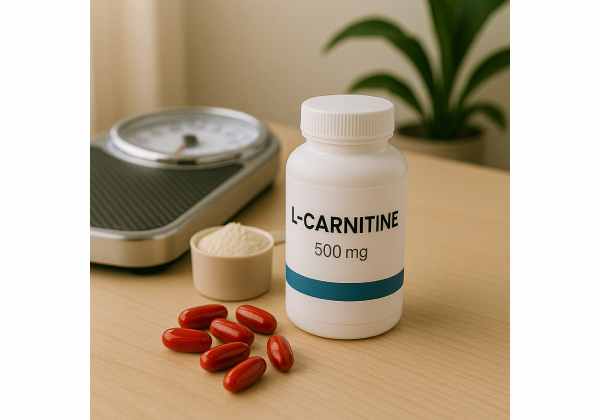L-carnitine has a clear job in human biology: it ferries long-chain fatty acids into the mitochondria, where they can be burned for energy. That role makes it a tempting supplement when weight loss is the target. But biology is not marketing. In trials, L-carnitine delivers modest average effects that depend on dose, form, training, and even your gut microbiome. This guide explains how L-carnitine works, who is most likely to benefit, how to choose a form and dose, and what side effects to watch for—so you can run a clean, safe experiment and decide if it is worth your time and budget. If you are comparing supplements with prescriptions or coaching programs, start with our overview of evidence-based weight management options to place L-carnitine in context.
Table of Contents
- What is L-carnitine and does it work?
- How L-carnitine supports fat burning
- Dose, forms, and timing that matter
- Who benefits and who does not
- Common mistakes and troubleshooting
- Side effects, risks, and interactions
- What results to expect and how to measure
- Frequently Asked Questions
What is L-carnitine and does it work?
What it is. L-carnitine is a quaternary amine synthesized in the liver and kidneys from lysine and methionine and stored mostly in muscle. Diet provides additional carnitine, especially from red meat and dairy. Inside cells, it acts like a shuttle: binding long-chain fatty acids, escorting them across the mitochondrial membranes via the carnitine transport system, and returning to repeat the process.
Why weight-loss seekers consider it. Because L-carnitine helps move fat into mitochondria, supplementing it might seem like “more carnitine → more fat burning.” The reality is narrower. In most healthy adults with adequate dietary intake, carnitine transport is not the sole rate-limiting step in fat loss; energy balance, protein intake, activity, sleep, and hormones matter more.
What the evidence suggests.
- Average effect: Small but measurable in some groups. Meta-analyses report modest reductions in body weight and fat mass over weeks to months, especially in individuals with lower baseline carnitine status, older adults, and people who pair supplementation with exercise and structured nutrition.
- Time frame: Expect any change to unfold gradually across 8–12 weeks, not days.
- Magnitude: Think additional fractions of a kilogram per month beyond what your plan already produces, not dramatic drops.
Where L-carnitine fits in a practical plan. Use it as an adjunct to a well-built program: a modest calorie deficit, 25–35 g protein per main meal, resistance training 2–4 days weekly, daily steps, and protected sleep. If you need a refresh on fundamentals before testing any supplement, skim our hub on safe weight loss basics.
Bottom line: L-carnitine can help some people by improving training output, recovery, or fat oxidation at the margins. Treat it like a small lever you pull only after the big ones are in place.
How L-carnitine supports fat burning
Understanding the “how” prevents overpromising and helps you decide where L-carnitine might assist your specific routine.
1) Fatty-acid transport into mitochondria
Long-chain fatty acids cannot cross mitochondrial membranes unassisted. The carnitine shuttle (CPT1 on the outer membrane, CPT2 on the inner) attaches carnitine to fatty acids, moves them inside, then releases them for β-oxidation. Supplementing L-carnitine increases plasma and sometimes muscle carnitine, which may improve transport capacity—most relevant when baseline carnitine is low (e.g., low dietary intake, aging muscle) or when demand is high (endurance activity).
2) Glycogen sparing and training support
By facilitating fat use at submaximal intensities, L-carnitine may spare muscle glycogen. Practically, some athletes report better endurance or reduced perceived exertion during steady work. For weight management, that can translate to more total activity and better adherence to a training plan.
3) Recovery and soreness
L-carnitine L-tartrate (LCLT) appears to reduce markers of exercise-induced muscle damage in some studies. Fewer sore days can mean more consistent sessions, which matter far more to fat loss than any capsule.
4) Insulin and transport into muscle
Carnitine uptake into muscle is insulin-dependent. Pairing L-carnitine with carbohydrate or a mixed meal can improve tissue uptake. This is one reason timing (Section 3) matters more than it does for many supplements.
5) The gut microbiome and TMAO
Some gut bacteria convert carnitine to TMA, which the liver converts to TMAO. Elevated TMAO is associated (not causally proven) with cardiovascular risk in epidemiology. Context matters—dietary patterns, renal function, and microbiome composition influence TMAO—so risk management focuses on dose, duration, and overall diet quality (see Safety).
6) Synergy with caffeine and training
Moderate caffeine can raise acute fat oxidation and training output. If you use caffeine strategically (early in the day, aligned with workouts), it may complement L-carnitine’s small effects. If you need guidance here, review our primer on caffeine dosing and safety to protect sleep and blood pressure.
Takeaway: L-carnitine can slightly improve the metabolic environment for burning fat and the behavioral environment by supporting training and recovery. Those nudges only matter when you already control calories, protein, movement, and sleep.
Dose, forms, and timing that matter
Choosing the right form, dose, and timing turns a vague experiment into a fair trial you can evaluate in two weeks.
Forms you will see
- L-carnitine (base) — the simplest form; doses are listed as milligrams of L-carnitine.
- L-carnitine L-tartrate (LCLT) — often used in sports supplements; research favors it for recovery and performance metrics.
- Acetyl-L-carnitine (ALCAR) — crosses the blood-brain barrier more readily; studied for cognitive support and neuropathic pain. For fat loss it can help some users with mental energy, which may indirectly aid adherence.
- Propionyl-L-carnitine — used more for vascular conditions than for weight control.
How much to take
- Start: 1,000 mg/day of L-carnitine (as base or LCLT) with a meal for 3–4 days.
- Typical target: 2,000–3,000 mg/day, split into 2–3 doses with meals.
- ALCAR: often 500–1,000 mg/day (some tolerate up to 2,000 mg/day), typically morning or early afternoon because of its alertness effect.
- Do not exceed label directions or escalate above ~3 g/day long-term without clinician guidance.
Timing and pairing
- With meals (or carbs + protein): Insulin facilitates carnitine uptake into muscle; pairing with a mixed meal improves the odds that supplementation raises tissue carnitine, not just plasma levels.
- Training days: If using caffeine, time caffeine before training and L-carnitine with the preceding meal (e.g., breakfast if you train mid-morning, lunch if you train after work).
- Hydration: Carnitine is osmotically active; plenty of water reduces GI complaints.
Label math and honesty checks
- Some labels list compound weight (e.g., “L-carnitine L-tartrate 1,000 mg”). That is not 1,000 mg of L-carnitine. Good brands disclose “delivers X mg L-carnitine.” If they do not, assume ~68% L-carnitine by weight for LCLT to estimate.
- Avoid proprietary blends that bury carnitine among stimulants—you cannot verify dose or safety. If label transparency is new to you, our guide on how to read supplement labels shows you the math.
How long to try
Give it two to four weeks at a steady dose and routine. Track appetite, training consistency, perceived recovery, and weekly weight trends. If nothing measurable improves by week four—or sleep or GI symptoms worsen—stop and reallocate the budget.
Capsules vs. liquids
Capsules are simple. Liquids absorb quickly but can taste sweet or medicinal and sometimes hide added sugars—check the panel.
Stacking with other supplements
- Pairs well with protein, creatine (for strength and lean mass), and caffeine (if sleep is protected).
- Avoid stacking with stimulant-heavy “fat burners.” You do not need yohimbine or synephrine to evaluate carnitine.
Who benefits and who does not
L-carnitine is not a universal booster. Certain profiles see more value.
More likely to benefit
- Older adults (age-related declines in muscle carnitine and mitochondrial efficiency).
- People with low dietary intake (vegetarian or vegan patterns) or low baseline plasma carnitine.
- Endurance or mixed-modality trainees who can capitalize on improved fat oxidation and recovery.
- Individuals prioritizing performance and adherence—more consistent training often yields the real gains.
Less likely to benefit
- High red-meat consumers with adequate carnitine intake and limited training.
- Short-sleepers or high-stress individuals—hormonal drivers of appetite and energy overshadow small metabolic nudges.
- People expecting dramatic, rapid fat loss from a capsule without changing diet or activity.
Case examples
- Desk worker, 42, training three days weekly: Moves from 6,000 to 9,000 daily steps and adds a fourth short session. With 2 g/day L-carnitine split with meals, reports less soreness and steadier energy. Over 12 weeks, sees slightly better adherence and a small extra loss versus prior attempts.
- Marathon trainee, 36: Uses 2–3 g/day LCLT with meals during peak weeks. Notes better legs on back-to-back days. Weight stable (by design), body composition improves.
- Vegetarian, 30: Adds 1.5–2 g/day and a stronger protein anchor at lunch; experiences better afternoon energy and fewer snack episodes.
Alternatives with higher predictability
- Soluble fiber before the hungriest meal for appetite control.
- Protein shakes to reliably hit 25–35 g protein per meal (see our guide to protein shakes for weight loss).
- Creatine to preserve lean mass in a deficit (for context, see creatine while losing weight).
Decision rule
If L-carnitine does not improve training consistency, recovery, or appetite control within four weeks, it is not your lever right now. Cut it and double down on sleep, protein, and fiber.
Common mistakes and troubleshooting
Avoid these pitfalls to give L-carnitine a fair shot—and to know quickly whether it helps.
Mistake 1: Chasing the wrong dose
Taking 500 mg/day and expecting pronounced effects, or dosing 3–4 g/day from day one and getting GI distress. Fix: Start at 1 g/day, aim for 2–3 g/day with meals, reassess in two weeks.
Mistake 2: Ignoring form and label math
“1,000 mg L-carnitine L-tartrate” ≠ 1,000 mg L-carnitine. Fix: Choose labels that state delivered L-carnitine or do the conversion. Skip proprietary blends.
Mistake 3: Taking it on an empty stomach
Fasting doses increase nausea and do not leverage insulin-mediated uptake. Fix: Take with a mixed meal (protein + carbs).
Mistake 4: Expecting appetite suppression
Carnitine is not a classic appetite suppressant. Fix: Pair with meal structure and, if needed, soluble fiber 15–30 minutes before your hungriest meal.
Mistake 5: Dosing late and impairing sleep
ALCAR can feel stimulating; caffeine stacks compound the problem. Fix: Dose earlier; if sleep is fragile, choose non-stim pairings and keep caffeine cutoffs strict (see caffeine timing basics).
Mistake 6: Ignoring quality
Unverified products can be underdosed or contaminated. Fix: Prefer brands with third-party testing and batch COAs. If you are new to seals and labs, start with our overview of independent testing programs.
Mistake 7: No stop rule
Dragging a neutral supplement for months wastes money and mental bandwidth. Fix: Write your stop rule on day one: “If no measurable improvement by week four, stop.”
Troubleshooting quick guide
- Nausea or cramps? Lower the dose, split across meals, and drink more water.
- No training benefit? Reallocate to creatine or coaching.
- Sleep disrupted with ALCAR? Move doses to morning or switch to LCLT.
- Fishy odor? Reduce dose and ensure good hygiene; if persistent, discontinue.
Side effects, risks, and interactions
Most healthy adults tolerate modest, food-paired doses well. That does not mean zero risk.
Common side effects (usually dose-related)
- GI upset: Nausea, stomach cramps, diarrhea—especially on an empty stomach or with rapid dose increases.
- “Fishy” body odor: From trimethylamine formation in some people; often resolves with dose reduction or discontinuation.
- Restlessness or headache: More common with ALCAR or stimulant stacks.
Less common but important
- Seizures: Rare reports of increased seizure frequency in those with seizure disorders taking ALCAR. If you have a history, consult your neurologist before use.
- TMAO concerns: Chronic high carnitine intake may raise TMAO in some individuals. While clinical significance remains debated, moderate doses, plant-forward diets, and attention to renal function are prudent.
Who should avoid or seek medical guidance first
- Pregnant or breastfeeding individuals: Avoid due to limited safety data.
- People with seizure disorders: Discuss ALCAR specifically with a clinician.
- Those with significant kidney disease: TMAO handling and carnitine balance can be altered.
- Individuals on anticoagulants or thyroid medications: Review timing and interactions with your clinician.
- Children and teens: Use only under medical supervision.
Medication considerations
- Thyroid replacement: Separate dosing if advised; changes in GI transit or supplements can affect absorption.
- Diabetes medications: Appetite, activity, and meal timing changes can alter glucose patterns; monitor when you change routines.
- Valproate: L-carnitine is sometimes used therapeutically for valproate-related issues; coordination with your prescriber is essential.
Quality and contamination
Choose brands with USP, NSF, or Informed Choice certification or batch COAs to reduce contamination risk. Be wary of “fat burner” blends that combine carnitine with multiple stimulants; most adverse events cluster around stacks, not simple carnitine.
When to stop immediately and seek care
- Dark urine, yellowing skin/eyes, severe abdominal pain, persistent vomiting, new neurological symptoms, or heart palpitations that do not resolve with dose/timing changes.
What results to expect and how to measure
Expectation setting determines satisfaction. Here is the realistic range and how to evaluate it.
Best-case scenario (with a solid plan)
- Slightly better fat oxidation during low-to-moderate activity.
- Improved recovery, enabling an extra weekly session or higher training quality.
- Small, cumulative changes in weekly energy balance (fewer skipped workouts, steadier energy) that add up to modest extra fat loss over 8–12 weeks.
Typical outcome
- In many people, effects are subtle—felt as steadier sessions or a bit less soreness—rather than big changes on the scale. Without deliberate nutrition and sleep, differences are negligible.
How to measure value
- Training log: Did total sets, reps, or minutes increase? Are back-to-back days more manageable?
- Recovery markers: DOMS ratings (0–10) the day after key workouts; fewer “I skipped because sore” days.
- Appetite and energy: Pre- and post-meal hunger scores; afternoon energy dips per week.
- Weekly trend: Compare your 4-week average weight change with and without L-carnitine under similar diet and activity conditions.
A two-decision framework
- Week 2 check-in: Tolerable? Any GI or sleep issues? If symptoms, adjust dose and timing. If neutral, continue to week 4.
- Week 4 decision: If training and recovery improved and weekly trend is a touch better, keep. If neutral/negative, stop and redirect funds to coaching, creatine, or fiber before meals.
High-ROI alternatives if carnitine is neutral for you
- Protein anchors at each meal (25–35 g).
- Soluble fiber before the hungriest meal.
- Resistance training progression and step count targets.
- Caffeine timed early and kept under your personal sleep threshold (details in caffeine timing).
Frequently Asked Questions
Does L-carnitine actually help with weight loss?
Sometimes, but the average effect is small. L-carnitine can support fat oxidation and recovery, which may improve training consistency. Expect gradual, modest changes over 8–12 weeks and only when paired with a structured plan for calories, protein, movement, and sleep.
What dose of L-carnitine should I take?
Most people trial 2,000–3,000 mg/day of L-carnitine (as base or LCLT) split with meals. Start at 1,000 mg/day for a few days to assess tolerance. ALCAR is typically 500–1,000 mg/day, earlier in the day. Do not exceed label directions without clinician guidance.
Which form is best: LCLT or ALCAR?
For training and recovery, L-carnitine L-tartrate is the go-to in sports research. For mental energy, acetyl-L-carnitine may help some users. For fat loss, both are adjuncts; choose based on tolerance, goal, and time of day you prefer to dose.
Should I take L-carnitine with food?
Yes. Pairing with a mixed meal improves tolerance and may enhance muscle uptake because carnitine transport is insulin-dependent. Fasting doses increase the risk of nausea without clear advantages for fat loss.
Are there side effects to watch for?
GI upset (nausea, cramps, diarrhea) and a fishy odor are the most common, usually dose-related. ALCAR can feel stimulating. Rarely, seizure frequency may increase in people with seizure disorders. Stop if severe symptoms occur and consult your clinician.
Who should avoid L-carnitine?
Avoid during pregnancy and breastfeeding. People with seizure disorders, significant kidney disease, or on medications with narrow therapeutic windows should seek medical guidance first. If sleep is fragile, avoid late ALCAR doses and stimulant stacks.
References
- The Effect of the L-Carnitine Supplementation on Obesity Indices: An Umbrella Meta-Analysis — 2025 (Systematic Review)
- L-Carnitine Tartrate Supplementation for 5 Weeks Improves Exercise Recovery in Men and Women: A Randomized, Double-Blind, Placebo-Controlled Trial — 2021 (RCT)
- Chronic oral ingestion of l-carnitine and carbohydrate increases muscle carnitine content and alters muscle fuel metabolism during exercise in humans — 2011 (RCT/Mechanistic)
- Carnitine – Health Professional Fact Sheet — 2023 (Government Fact Sheet)
- Revisiting the Role of Carnitine in Heart Disease Through the Lens of the Gut Microbiota — 2024 (Review)
Disclaimer
This article provides general information and is not a substitute for professional medical advice, diagnosis, or treatment. Always consult a qualified healthcare professional before starting, stopping, or combining supplements—especially if you take prescription medications, are pregnant or breastfeeding, have seizure disorders, kidney disease, or other chronic conditions.
Share and follow
If this guide helped you evaluate L-carnitine clearly, please share it with someone comparing weight-loss supplements. For calm, evidence-based updates on nutrition and training, follow us on the social platform you use most—Facebook, X, or another network you prefer. Your feedback helps us keep these guides practical.

















